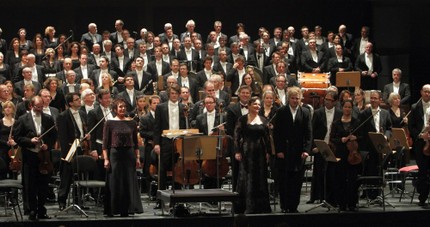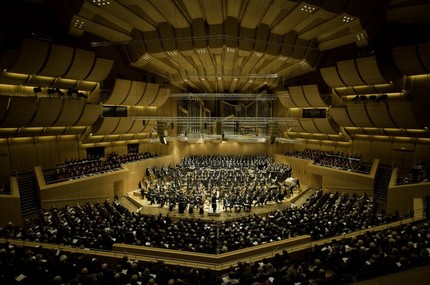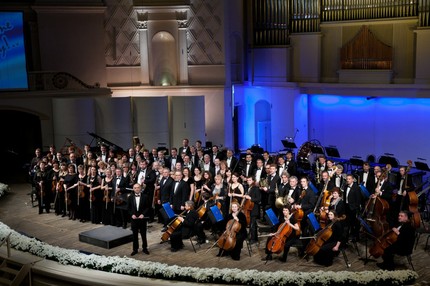
Bavarian State Orchestra (Bayerisches Staatsorchester) |
Bavarian State Orchestra

The Bavarian State Orchestra (Bayerisches Staatsorchester), which is the orchestra of the Bavarian State Opera, is one of the most famous symphony ensembles in the world and one of the oldest in Germany. Its history can be traced back to 1523, when the composer Ludwig Senfl became cantor of the Court Chapel of the Bavarian Duke Wilhelm in Munich. The first famous leader of the Munich court chapel was Orlando di Lasso, who officially assumed this position in 1563 during the reign of Duke Albrecht V. In 1594, the duke founded a boarding school for gifted children from poor families in order to educate the younger generation for the court chapel. After the death of Lasso in 1594, Johannes de Fossa took over the leadership of the Chapel.
In 1653, at the opening of the new Munich Opera House, the Capella Orchestra performed for the first time G. B. Mazzoni’s opera L’Arpa festante (before that, only church music had been in its repertoire). In the 80s of the XNUMXth century, many operas by Agostino Steffani, who was the court organist and “director of chamber music” in Munich, as well as other Italian composers, were performed in the new theater with the participation of the orchestra.
Beginning in 1762, for the first time, the concept of an orchestra as an independent unit was introduced into everyday life. Since the mid-70s of the XVIII century, the regular activity of the Court Orchestra begins, which performs numerous opera premieres under the direction of Andrea Bernasconi. The high level of the orchestra was admired by Mozart after the premiere of Idomeneo in 1781. In 1778, with the coming to power in Munich of the Mannheim elector Karl Theodor, the orchestra was replenished with the famous virtuosos of the Mannheim school. In 1811, the Academy of Music was formed, which included members of the Court Orchestra. Since that time, the orchestra began to participate not only in opera performances, but also in symphony concerts. In the same year, King Max I laid the foundation stone for the building of the National Theatre, which was opened on October 12, 1818.
During the reign of King Max I, the duties of the court orchestra equally included the performance of church, theatrical, chamber and entertainment (court) music. Under King Ludwig I in 1836, the orchestra acquired its first chief conductor (General Music Director), Franz Lachner.
During the reign of King Ludwig II, the history of the Bavarian Orchestra is closely connected with the name of Richard Wagner. Between 1865 and 1870 there were premieres of his operas Tristan und Isolde, Die Meistersingers of Nuremberg (conductor Hans von Bülow), Rheingold and Valkyrie (conductor Franz Wüllner).
Among the conducting elite of the last century and a half there is not a single musician who has not performed with the orchestra of the Bavarian State Opera. Following Franz Lachner, who led the group until 1867, it was led by Hans von Bülow, Hermann Levy, Richard Strauss, Felix Mottl, Bruno Walter, Hans Knappertsbusch, Clemens Kraus, Georg Solti, Ferenc Frichai, Josef Keilbert, Wolfgang Sawallisch and other famous conductors .
From 1998 to 2006, Zubin Mehta was the chief conductor of the orchestra, and starting from the 2006–2007 season, the outstanding American conductor Kent Nagano took over as conductor. His activity in the Munich theater began with the premiere productions of the mono-opera of the contemporary German composer W. Rim Das Gehege and R. Strauss’s opera Salome. In the future, the maestro conducted such masterpieces of the world opera theater as Mozart’s Idomeneo, Mussorgsky’s Khovanshchina, Tchaikovsky’s Eugene Onegin, Wagner’s Lohengrin, Parsifal and Tristan and Isolde, Electra and Ariadne auf Naxos » R. Strauss, Berg’s Wozzeck, Bernstein’s Tahiti Unrest, Britten’s Billy Budd, premieres of the operas Alice in Wonderland by Unsuk Chin and Love, Only Love by Minas Borbudakis.
Kent Nagano takes part in the famous Summer Opera Festival in Munich, regularly performs with the Bavarian State Orchestra in symphony concerts (at present, the Bavarian State Orchestra is the only one in Munich that takes part in both opera performances and symphony concerts). Under the leadership of maestro Nagano, the team performs in the cities of Germany, Austria, Hungary, participates in internship and educational programs. Examples of this are the Opera Studio, the Orchestra Academy, and the ATTACCA Youth Orchestra.
Kent Nagano continues to replenish the band’s rich discography. Among the latest works are video recordings of the operas Alice in Wonderland and Idomeneo, as well as an audio CD with Bruckner’s Fourth Symphony released on SONY Classical.
In addition to his main activities at the Bavarian Opera, Kent Nagano has been Artistic Director of the Montreal Symphony Orchestra since 2006.
In the 2009-2010 season, Kent Nagano presents the operas Don Giovanni by Mozart, Tannhauser by Wagner, Dialogues of the Carmelites by Poulenc and The Silent Woman by R. Strauss.
Source: Moscow Philharmonic website





